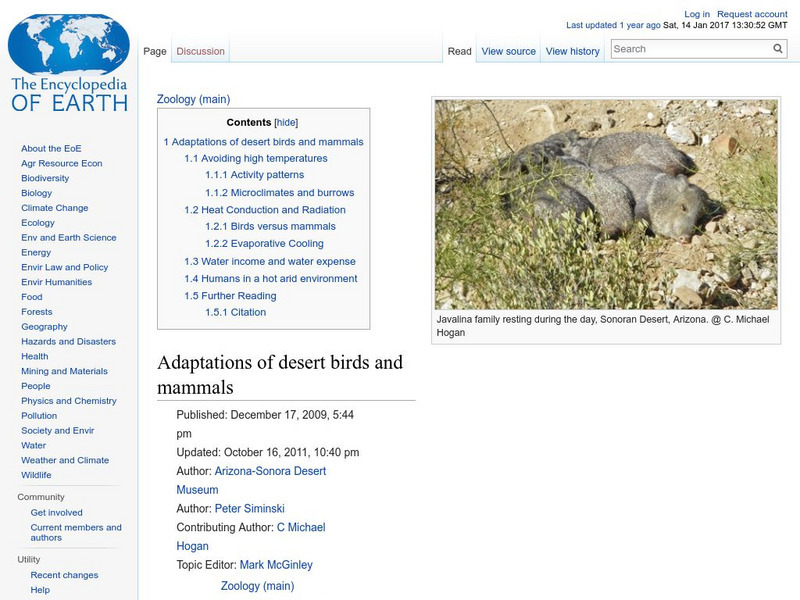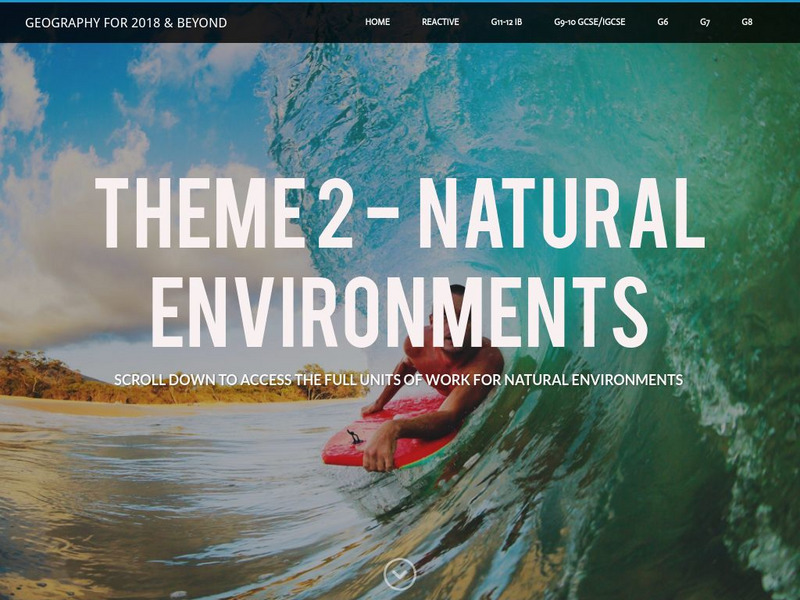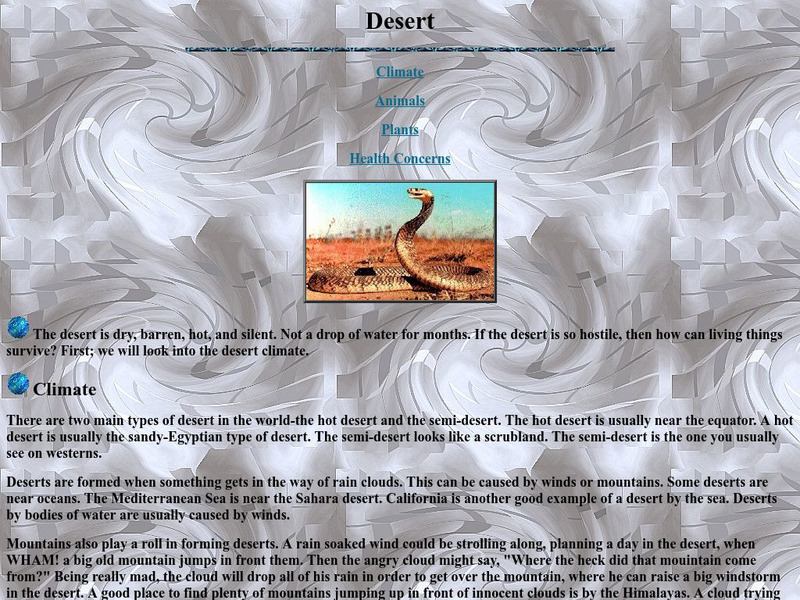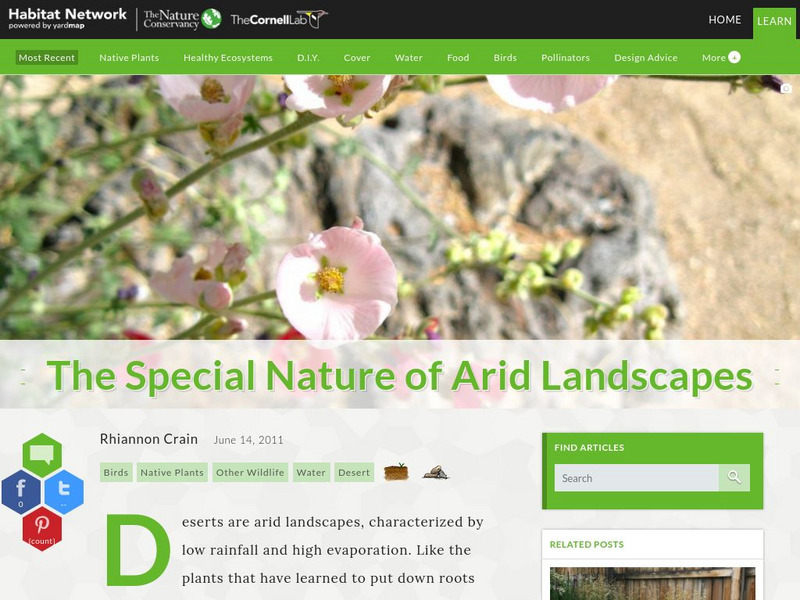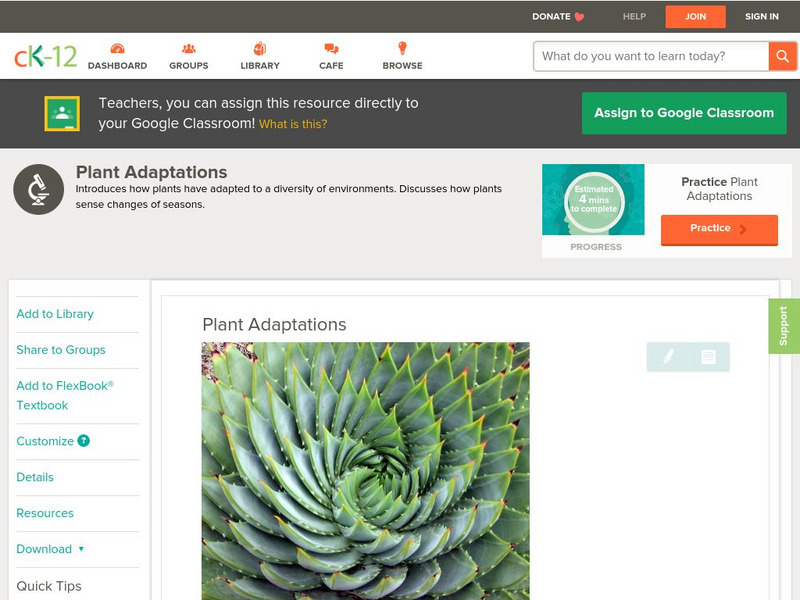Hi, what do you want to do?
Curated OER
Treaties
Students talk about making promises. In this family life lesson, students listen to the story A Promise is a Promise by Robert Munsch and talk about what a promise is. This is part of a unit on how families take care of each...
Curated OER
Discovering the Past Using the Future: Remote Sensing and the Lost City of Ubar
Students use a video, maps, worksheets and Internet research to explore the role that sensing played in locating Ubar - the lost city of Arabia.
Encyclopedia of Earth
Encyclopedia of Earth: Adaptations of Desert Amphibians and Reptiles
The evolution of amphibians from prehistoric days is described, and the challenges they face when living in a desert environment, of which the ability to reproduce is the greatest. How they manage to survive in a desert is explained in...
Encyclopedia of Earth
Encyclopedia of Earth: Adaptations of Desert Birds and Mammals
The ways in which animals have adapted so as to survive in a desert environment are described in this article. Mechanisms that humans have to help them cool themselves in a desert are also explained. (Published: December 17, 2009)
Encyclopedia of Earth
Encyclopedia of Earth: Adaptations of Desert Plants
The ways in which plants have adapted through evolution in order to survive in a desert environment are described in this article. Getting water and retaining water are key to their survival, including protecting themselves from animals...
Geographypods
Geographypods: Theme 2: Natural Environments
A rich collection of highly engaging learning modules on topics related to the natural environment. Covers four main areas - plate tectonics, forms and processes, weather and climate, and rainforest and desert. Within each of these,...
US Geological Survey
Deserts: Geology and Resources
The U.S. Geological Survey provides information on what a desert is, how the atmosphere influences aridity, where deserts form, types of deserts, desert features, eolian processes, types of dunes, remote sensing of arid lands, mineral...
Globio
Glossopedia: Environments
This article defines "environment" as a collection of animals and plants in a specific landscape and climate. The concept of differing types of environments is introduced. The impact of humans on environments and all environments'...
Science Struck
Science Struck: Arabian Desert Facts
Presents interesting information about the Arabian Desert, including its physical geography, climate, plants and animals, their adaptations to the environment, natural resources, and threats to its habitats.
Other
Thurston High School: Sharryl Lattion and Melissa Femrite: Biomes: Desert
Written for younger readers, this article reveals facts about animals and plants as well as health concerns for people in the desert environment.
Utah Education Network
Uen: Trb 4:5 Investigation 5 Desert Dynamics
Fourth graders will understand how plants and animals adapt to their environment.
Cornell Lab of Ornithology
Habitat Network: The Special Nature of Arid Landscapes
Find out how to make the most of a desert environment in order to foster a wide array of species diversity.
Other
Greatest Places: Namib
Explore the Namib Desert and learn about its location, the Skeleton Coast, mirages, and general information about this home to the highest sand dunes in the world.
Other
Ancient Mysteries: Gobi Desert Mysteries
This site details information about the mysteries of the Gobi Desert, an area actually comprised more of mountains than desert. This site has a map of the Gobi area, photos of the Gobi, as well as links to information about ancient...
The History Cat
The History Cat: Geography: Environment: The Incredible Shrinking Sea
Describes the economic policies of the Soviet Union that turned the Aral Sea, once the world's largest body of fresh water, into two smaller seas and desert. Includes a video. [10:29]
National Geographic Kids
National Geographic Kids: Animals: Bactrian Camel
Great site for youngers researching the Bactrian camel. Video clip, photos, and easy to read facts about habitat, young, enemies, food, adaptation to environment, and humps!
Utah Education Network
Uen: Trb 4:5 Investigation 1 Wetlands, Forests & Deserts
Learn about surface terrain and how plants and animals are affected by the temperatures and precipitation.
Curated OER
Bureau of Land Management: Alaska's Cold Desert
Learn about the Arctic tundra biome of Alaska. A discussion of its characteristics, and the animals and the plants that live there.
The History Cat
The History Cat: Geography: Environment: Fighting Desertification
Lists reasons we should be concerned about desertification and discusses how the Sahel region south of the Sahara Desert is becoming desertified.
Extreme Science
Extreme Science: Hottest Place on Earth: Lut Desert, Iran
A description of the climate in Lut Desert, Iran, which was documented as having repeatedly reached the highest temperatures of anywhere on Earth. Includes explanation of how extreme heat occurs.
American Forum for Global Education
American Forum for Global Education: Challenge of the Desert
This elementary exploration of interdependence from the American Forum for Global Education touches on language arts, social studies, and science. Students understand the connection between themselves and their natural environment.
CK-12 Foundation
Ck 12: Biology: Plant Adaptations
[Free Registration/Login may be required to access all resource tools.] An overview of how plants have adapated to their environments.
Curated OER
Science Kids: Science Images: Desert Trees
This photo shows a number of desert trees that are found living in the hot, harsh, desert environment.
Curated OER
Wikipedia: National Historic Landmarks in Arizona: Desert Laboratory
Founded in 1903 to study plant adaptation to an arid desert environment with long term experiments, this laboratory contributed significantly to the formation of Ecology as a science. Part of the University of Arizona.








